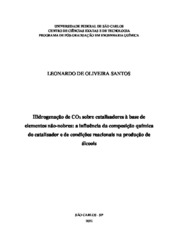Hidrogenação de CO2 sobre catalisadores à base de elementos não-nobres: a influência da composição química do catalisador e de condições reacionais na produção de álcoois
Abstract
Strategies to reduce CO2 emissions and control the increase in atmospheric levels of this gas are urgent. A promising approach to help minimize the accumulation of CO2 in the atmosphere and the corresponding negative environmental impacts includes the use of CO2 as a feedstock for fuel schemes such as methanol and ethanol, for example. These compounds can be synthesized by CO2 hydrogenation through heterogeneous catalysis. Results obtained recently in our research group observed that the catalytic hydrogenation of CO2 on pure copper in the presence of water vapor as a source of hydrogen leads to the formation of methanol and ethanol as reaction products at atmospheric pressure. Despite these advances, the system has been underexplored until the moment and some aspects still need to be clarified. Considering the reaction under atmospheric pressure conditions, it is not known about the performance of materials in the absence of water, using only CO2 and H2, and about the impact of the gradual addition of water vapor to the CO2 and H2feed stream in the production of alcohols. Investigations like these are essential for a better understanding of the catalytic system and for identifying reaction conditions favorable to the synthesis of specific products. This aspect will be further explored in this work. Here, CuO and CuO/ZnO/Al2O3 catalysts were synthesized by the (co-)precipitation method. The CuO/ZnO/Al2O3 catalyst was promoted by wet impregnation with K or Cs. The synthesized materials were characterized by thermogravimetric analysis (ATG), X-ray diffraction (XRD), X-ray fluorescence spectrophotometry, N2 physisorption and temperature programmed reduction with H2. Initially, the catalysts were used in the hydrogenation reaction of CO2 with H2. The catalytic performance of Cu and Cu/ZnO/Al2O3 was evaluated at a temperature of 473,15 K in molar ratios of H2/CO2 = 1, H2/CO2 = 3 and H2/CO2 = 5. The molar ratio of H2/CO2 = 3 favored the productivity to alcohols and, among the investigated materials, the Cu/ZnO/Al2O3 catalyst was the one that presented the highest productivity of methanol and ethanol, 220 and 0.13 µmol g-1Cuh-1, respectively, at a temperatureof 473,15 K. The addition of water vapor to the CO2 and H2 feed stream resulted in an inhibition of alcohol productivity in the Cu, Cu/ZnO/Al2O3, K-Cu/ZnO/Al2O3 and Cs-Cu/ZnO/Al2O3 catalysts. These results indicate that, in the hydrogenation of CO2 in the presence of H2 and water vapour, the adsorption of water competes with the adsorption of other species for active sites of the catalyst, disfavoring the formation of alcohols.
Collections
The following license files are associated with this item:

